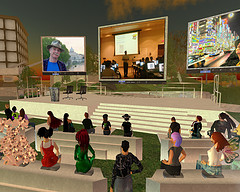Continuing Challenges
If there is one central point I am trying to make here, it is that iTunes University is only one small part of a far larger shift toward convergent media networks where text, video, image, animation, and sound will come together to be composed and communicated through a wide range of devices from iPods and mobile phones to televisions and PCs. The challenges that result are not only technical or institutional but they are intellectual and disciplinary as well as we are forced to consider how our disciplinary paradigms have been shaped by the technological conditions of a print culture, conditions that are quickly fading away.
As we continue to keep up with technological innovation, we see our next venture as entering into the 3-D web space of Second Life. Arguably the demand for technological currency is less pressing in first-year composition programs than in professional writing majors; certainly within our program, the ability to offer students some experience with communication in emerging media networks appears to be an important component of their education. We foresee audio and video podcasting, and iTunes U in particular, as continuing to be important as we move into this so-called "virtual world." One established practice in Second Life has avatars meeting to view video or listen to audio. As enticing as the virtual environment may be, perhaps one of the real attractions of Second Life, at least for education, is the capacity it has for overlapping social networking and collaboration over existing media (as if we were sitting together in a room watching and discussing a video).
 Perhaps the most difficult aspect of this ongoing innovation is faculty development. As a specialist in new media composition, I've become accustomed over the last five years to the relentless pace of emerging technologies. However, for my colleagues the challenge is new. If we are to take real advantage of these technologies and help our students to understand the possibilities of networked media, we must infuse these practices across the curriculum. As it turns out, learning the technical matters of networked media composition proves to be only a minor challenge in comparison to reshaping one's pedagogic practice. From this perspective we have only begun to experiment with the implications of working in a media network that cuts across our courses.
Perhaps the most difficult aspect of this ongoing innovation is faculty development. As a specialist in new media composition, I've become accustomed over the last five years to the relentless pace of emerging technologies. However, for my colleagues the challenge is new. If we are to take real advantage of these technologies and help our students to understand the possibilities of networked media, we must infuse these practices across the curriculum. As it turns out, learning the technical matters of networked media composition proves to be only a minor challenge in comparison to reshaping one's pedagogic practice. From this perspective we have only begun to experiment with the implications of working in a media network that cuts across our courses.